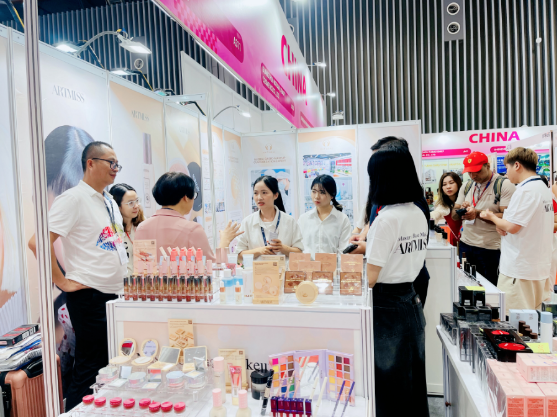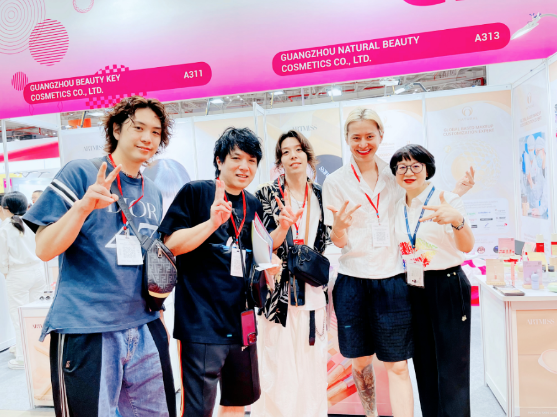Domestic beauty brands Venturing into Vietnam | New and Old players competing, How to Position to Ensure "Profit Prospects"?
Release Time:
Jun 26,2025
Domestic beauty products going global - Vietnam
In the current situation of overconsumption in Vietnam, it has become a consensus for domestic beauty products to seize new markets. Among the waves of going global, one of the strategies for domestic products to "expand their territory" is to expand outward.
Vietnam borders China to the north and is surrounded by the sea on three sides, with vast water areas. Thanks to its outstanding geographical location, it has become a "gold mine" for Chinese cosmetics enterprises. Especially in recent years, bilateral trade between China and Vietnam has developed rapidly. China has been Vietnam's largest trading partner for many consecutive years, and Vietnam is also China's largest trading partner in ASEAN and the fourth largest trading partner in the world.
Therefore, in the layout of domestic beauty products going global, Vietnam has become a "must-win territory". However, against the backdrop of the global overall improvement in consumer awareness, the relatively extensive overseas business model of the past is gradually declining. At present, the Vietnamese market needs domestic beauty products to build a refined structure and establish a communication chain with local users in order to possibly secure a long-term position in consumers' minds.

2024-07/25-27
The scene of the Lai Qian International Beauty Expo in Ho Chi Minh City, Vietnam
Market Insight
What potential for development does the beauty market in Vietnam actually hold?
According to the release of Vietnam's General Statistics Office, Vietnam's gross domestic product (GDP) growth rate in 2022 reached as high as 8.02%, which is the highest record in the country in the past 25 years. This far exceeds the previous target of 6.0% to 6.5% set by the Vietnamese government, fully demonstrating the vigorous vitality of the Vietnamese economy.
From the market perspective, the beauty industry in Vietnam has also shown a rapid growth trend. It is reported that in 2022, the revenue of Vietnam's cosmetics retail market reached 2.2 billion US dollars, and it is expected to exceed 2.7 billion US dollars by 2027. Behind this growth trend lies the support of Vietnam's young population structure - in 2023, Vietnam's population successfully exceeded 100 million, with 61% of the population under the age of 35. The huge young consumer group provides a broad market space for beauty products.
As the middle class in Vietnam continues to grow, the demand for beauty and health products keeps rising. The Vietnamese government strongly supports the development of the cosmetics industry and has introduced a series of encouraging policies, covering tax incentives, research and development support, intellectual property protection and other aspects, creating favorable conditions for market development.
In addition, the rapid development of e-commerce in Vietnam has also brought new opportunities to the beauty market. It is understood that Vietnam has 74.5 million Internet users, among whom 55.7 million have participated in or are passionate about online shopping. It is estimated that by 2025, the e-commerce market size will reach 39 billion US dollars.
Overall, as one of the world's fastest-growing economies, Vietnam's cosmetics industry is in a period of rapid development. The large consumer base and low-cost labor force indicate that domestic beauty products are in a relatively favorable stage for going global to the Vietnamese market. Despite the numerous variables in the market, its huge potential should not be underestimated. Therefore, many enterprises have begun to actively explore this field full of opportunities.
Channel Insight
With the continuous advancement of China's "Belt and Road Initiative", economic and trade cooperation between China and Southeast Asian countries has become increasingly close, creating an excellent external environment for Chinese beauty brands to enter the Southeast Asian market.
In the first quarter of 2024, the e-commerce market in Vietnam performed outstandingly, with total sales increasing by 78.69% year-on-year. Among them, the sales of beauty products rose by nearly 150%, becoming an important source of income for e-commerce platforms.
At present, the penetration rate of e-commerce in Vietnam still needs to be improved. This means that even if a brand performs well in the e-commerce channel, its overall market share is still difficult to reach a high level, and the payment method is still mainly offline cash payment. Therefore, when brands go global to Vietnam, they need to strategically select target channels.
If we focus on the cosmetics market in Vietnam, it is extremely important to deeply explore the main channels through which local Vietnamese consumers purchase beauty products.
According to market research, when Vietnamese consumers purchase beauty products, they mainly rely on three channels: brand direct stores, drugstores and cosmetics stores, and e-commerce websites. More than half of the consumers prefer to make purchases through offline channels.
Brand Insight
So, how should we evaluate the competition among beauty brands in the Vietnamese market? The answer is: International brands hold the upper hand, while Korean beauty brands dominate. When domestic beauty products enter the market, they will face a "head-on confrontation" situation!
In the Vietnamese cosmetics market, international brands hold an absolute dominant position, with a market share of 90%. Among them, South Korean beauty products hold the top position with approximately 30% of the market share, becoming Vietnam's largest source of cosmetic imports. Vietnam is also the country that loves South Korean beauty brands the most globally.
Therefore, when Chinese brands enter the Vietnamese market, they will face fierce competition from both new and established brands. At the same time, they need to consider how to break the established image of Korean brands in the minds of consumers and how to respond to the rise of local Vietnamese brands.
However, some domestic beauty brands have still gained a certain position on Vietnamese e-commerce platforms by relying on their advanced experience in the domestic e-commerce field and flexible strategies in the face of the pressure from both new and established brands. These brands collaborate with Kols through online marketing, attracting the attention of Vietnamese users with distinctive marketing content, thereby rapidly enhancing their brand awareness.
Consumption Insight
No matter which new market one enters, the core point lies in facing consumers and what is produced is a product. If one judges the brand value without considering this essence, deviations will occur.
Compared with China, Japan and South Korea in East Asia, Vietnam is clearly a highly dynamic cosmetics consumption market. At the same time, there is also a common "appearance level anxiety" among East Asian women. Here, as high as 93% of women aged 25 to 32 have the habit of regularly using skin care products. On average, they spend 436,000 Vietnamese dong (approximately 132 RMB) per month on beauty and skin care. This demographic dividend offers huge potential for enterprises to explore new markets.
Vietnamese consumers have a special preference for skin care products. They generally believe that compared with makeup, skin care is a more important part. Due to the hot and humid climate in Vietnam, female consumers are troubled by tanning and developing spots on their skin. Therefore, they pay particular attention to functional products such as whitening, moisturizing and spot-removing ones.
When it comes to the appearance and functionality of products, Vietnamese consumers do not merely pursue good looks on the outside; they also attach great importance to the cultural connotations of the products. Products with traditional national symbols are more likely to be popular.
Therefore, the core objective of domestic beauty brands going global is not merely to sell products, but more importantly, to deeply understand and meet the specific needs of the target market and accurately identify the target consumer group. Only through precise consumer positioning, efficient marketing strategies and excellent customer service can one firmly establish a foundation in the local market and achieve long-term sustainable development.
Entry Insights
In China, as the government's economic development plans are often accompanied by strong supporting policies, the development of the domestic beauty industry has also benefited from the completeness of infrastructure and supporting resources such as the Internet, e-commerce, and new retail.
To succeed in the Vietnamese market, domestic beauty enterprises must understand that backward infrastructure and differentiated consumer concepts cannot be changed in the short term. Only after having a clear understanding of the limitations of the market can one discover and seize the latent opportunities.
As a developing country, Vietnam is confronted with numerous common problems similar to those of backward markets. Therefore, the overseas expansion journey of domestic beauty brands in Vietnam has not been smooth sailing. This requires domestic beauty brands to bridge cultural differences, adapt to unfamiliar market environments, deal with complex regulations, and build brand-new supply chains. This is both a challenging business exploration and a cultural exchange that transcends national boundaries.

2024-07/25-27
The scene of the Lai Qian International Beauty Expo in Ho Chi Minh City, Vietnam
The way to break the deadlock
The all-channel construction breaks through the predicament of brand influence
Most domestic beauty brands in the Vietnamese market generally have the problem of insufficiently unique brand positioning and stories, making it difficult to establish an emotional connection with consumers. As a result, brand influence and brand premium sales have become major challenges.
According to relevant research, regarding the degree of influence of foreign cultures on Vietnam, Vietnamese consumers pay more attention to brands and cultures from South Korea and Japan, and have a relatively high recognition of China's technology and innovation. The cultural influence of South Korea and Japan is the greatest, followed by that of the United States and Europe. Among the Asia-Pacific countries, Singapore and Thailand rank high, while the cultural influence of China ranks 10th.
In terms of the influence of beauty brands, Vietnamese consumers have limited knowledge of Chinese cosmetic brands and a low level of brand trust, which seriously affects the purchasing decisions of local consumers. Local consumers' impression of "Made in China" is relatively backward, still remaining at the stage of "low price and poor quality". Brands that have entered the market have yet to change the above-mentioned impression of domestic beauty brands held by Vietnamese consumers.
Therefore, domestic beauty brands need to conduct on-site research. As more and more brands take advantage of the rise of social media and the subtle influence of soft marketing, overseas consumers are gradually developing an interest in Chinese beauty products, which has given many domestic enterprises the motivation to keep making progress in the Vietnamese market.
Moreover, the "crucial step" in building brand influence is to establish offline channels. At present, domestic beauty enterprises' overseas expansion may be limited to the "online" market, neglecting the offline opportunities. However, Vietnam's offline economy is very active, and online promotion and offline traffic diversion remain a feasible path.
Formulate corresponding overseas expansion models based on the development stage of the enterprise
For domestic beauty brands venturing into the Vietnamese market, how to maintain their own advantages and layout pace while resisting the impact of multi-brand competition in the Vietnamese beauty market is a long-term challenge. For instance, even though China's supply chain has a strong overall strength, when it comes to Korean and European and American brands that have been deeply rooted in the Vietnamese market for many years and have a strong influence there, domestic beauty products are still losing ground step by step.
Therefore, it is suggested that domestic beauty brands entering the Vietnamese market formulate corresponding overseas expansion models based on their own development stages, and adopt flexible and innovative strategies to win the survival space in the Vietnamese market. Regarding the ways for domestic beauty products to enter the Vietnamese market, they mainly fall into three categories: product export, local export, and brand export.
The core of the product overseas expansion model is to quickly introduce the product to the target market, mainly through distributors or online platforms. Its characteristic is to make the least adjustments to the existing products and quickly adapt to the market. The advantage of this strategy is that the initial investment is low and the returns are quick, but it may face problems such as insufficient brand promotion and a short product life cycle.
The domestic model of going global needs to focus on the matching of cultural adaptability and market demand. It reduces costs and improves supply chain efficiency by producing or storing locally. Although the initial investment is relatively large and the market risks are concentrated in warehouse management and compliant development, it can better meet the demands of local consumers.
The brand's overseas expansion model not only focuses on sales but also places greater emphasis on brand building and localization. It adopts an integrated marketing strategy, including advertising, public relations activities and local marketing activities, and deepens brand influence through the combination of online and offline and cooperation with endorsers. This model requires long-term investment, including market research, brand promotion and channel construction, and needs to flexibly adjust strategies to adapt to market changes. However, it can help the brand extend its life cycle and enhance user loyalty.
Enterprises that choose the brand overseas expansion model need to be prepared for long-term investment, including market research, brand promotion and channel construction, and their products and marketing strategies need to be significantly adjusted at any time in response to market changes. In addition, domestic beauty brands need to establish an effective supply chain and logistics system to ensure that products can reach consumers in a timely and efficient manner. This includes choosing the right distribution channels and partners, as well as addressing potential logistics and supply chain challenges. In summary, only by fully understanding the Vietnamese market and accurately identifying the target market and products in advance can one precisely select a layout model that suits oneself.
The way to strike a balance between product quality and pricing
In the consumer markets of Southeast Asia, including Vietnam, a significant polarization trend is emerging: on the one hand, the sales growth momentum of high-end consumer products is strong; On the other hand, some brands that are renowned for their cost-effectiveness and can help the middle class lead a more decent life are also rising rapidly.
In the face of this market environment, domestic beauty brands need to make two changes in thinking when going global. First of all, shift from a simple traffic mindset to a user mindset, focusing on the connection between the brand and users as well as the insight into user needs. Secondly, as domestic beauty brands shift from order-oriented to brand-oriented, with the continuous rise in traffic costs, they should pay more attention to enhancing product quality. Through brand influence, they can have a long-term impact on overseas consumers, increase repurchase rates and return rates.
Given that Vietnamese cosmetic consumers are generally young and have limited purchasing power, domestic beauty enterprises still need to focus on cost control and product quality in their current product strategies to maintain market competitiveness. In addition, product research and development as well as localization transformation are also important ways to enhance consumer trust.
Vietnam has relatively low labor costs and a mature supply chain and manufacturing system, which can provide Chinese enterprises with the advantage of producing at a lower cost and conducting large-scale manufacturing.
Although benchmarking China's development path can provide insights into Vietnam's future trends, the growth rate of Vietnam's supply chain is clearly much faster than that of China in its early stage. At that time, China was in the late stage of industrialization and on the eve of informatization, while Vietnam's industrial development was established in the process of transforming from informatization to intelligence, and its development speed will be even more rapid.
Meanwhile, when cosmetic brands invest and build factories in Vietnam, they can not only take advantage of Vietnam's land, labor, infrastructure and other benefits, as many natural herbal ingredients can be purchased locally, enabling the production of lower-cost products, but also take advantage of Vietnam's import and export tariffs and free trade agreement benefits to radiate the entire Southeast Asian market.
Summary
With the popularization of mobile Internet in Vietnam empowering online channels and the spread of new concepts and demands among a large population base, domestic beauty brands do indeed have some potential space in the local market.
Meanwhile, Vietnam has signed free trade agreements with several countries, including China. These agreements have lowered trade barriers and created new opportunities for Chinese cosmetics companies to export products to Vietnam.
At present, the focus of domestic beauty enterprises venturing into Vietnam should be on those areas with genuine demand and controllable policy risks. After all, it is ultimately the choices of local consumers that determine the success or failure of a brand in the market.
Including Laiqian International, it has also made important arrangements for domestic products to go global in Vietnam, including the upcoming opening of a branch in Ho Chi Minh City, Vietnam.
From a macro perspective, the Vietnamese market still faces many uncertainties, such as incomplete infrastructure and delays in online orders caused by a fragmented logistics system. However, in the long run, Vietnam is entering a major trend of economic development and industrial upgrading. Chinese enterprises should seize the positive changing factors in this process, constantly adjust their strategies, and seek new development opportunities through flexible and innovative approaches.
Previous
Related Blog
Jun 26,2025
Jun 26,2025
Beauty Industry Insights: Insights into Industry Development through Data
Jun 26,2025




